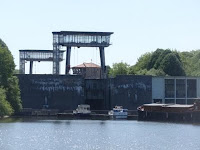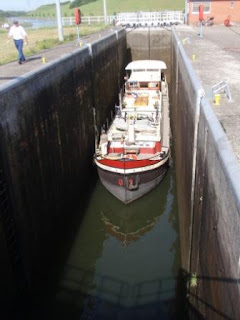We left indeed, as planned, Antwerp on the Friday. From the Willemdok to the Scheldt takes as the crow flies no time at all but with all the bridges, waiting for the lock and the time it takes for the lock to fill (with ships, four large commercial ships and 2 like us) and empty (the water) it took more than three hours before we really were on the way.
 |
| from Willemdok to the Scheldt |
But then we went, with the tide that flows fast in the Scheldt.
We went through the lock at Klein Willebroek so we could sleep peacefully before the next day we joined the large commercial canal again. We had to wait more than half an hour, on the tidalside before we could enter the lock and that meant going down a bit with the flow and than increasing the power to go back, but Klein Willebroek was a nice place (the lock keeper wanted us to stay at least a week because he liked the boat).
 |
| quay at Klein Willebroek |
Saturday, we continued and although the Sea Canal Brussels Scheldt is a major and commercial route all we met were two ships and we were overtaken by none.
So not to busy.
The route went through Brussels and once you pass the Budabridge you know you’re in Brussels, that one is really a gate to the city.
 |
| Buda closed |
 |
| Buda open |
We stopped in Halle and on Sunday sailed the last piece to Ronquieres.
After Halle the scenery was greener and more rural, very nice after a time in industrial surroundings and cities, although that certainly has its charm.
We still had to go through the lock at Ittre, 14 meters fall, but you can use floating bollards witch makes it very easy.
Quite different from the other lock where we had to go up only 4.5 m but there were no bollards in the wall so I had to go up a slippery ladder to the quay and from there take the lines up from Michel who stayed aboard, brrrrrr. I hope I don’t have to do that to often.
 |
| floting bollard, sometimes it feels like they get stuck wich is scary |
The Ittre lock was very impressive, before we went in it looked big but once inside, when you look back and the doors are closed it looks like you're in a wet, gray gorge because you see only air and water.
Then they pump it full and all looks friendly again when you’re out
 |
| Ittre, seen from the north |
 |
| Ittre, inside |
After a while we rounded a bend and there was the Plan incliné de Ronquieres before us, in all its glory.
We were there in 2005 by car, we were impressed then and have since been looking forward to the moment we owned a ship and could go up ourselves.
Well it took a couple of years, a lot of money and a lot of energy ... ... ... ... ... but then you have some!
 |
| Ronquieres at the bottom, as seen from the north |
The next day we went up, the ship sails into a tank and behind you the doors close. The whole tank, including quays, lock house and lanterns, is hoisted up on rails. There is a counter-weight that goes down underneath the tank, once up the front door opens and you exit.
The slope is 6% over a distance of 1500m and you go 70 meters up.
According to information on wikipedia is on the list GTI (grande traveaux inutile-great useless works).
 |
| looking back |
 |
| the counterweight that passes under the tank |
 |
| that is where we are going |
 |
| looking back again, once outside |
The next day we had our second lock we had been looking forward to, the Strépy-Thieu lift, that took us 76m down again and that’s how we crossed the mountain.
This lift is very different, very new it opened 2002.
 |
| 't Majeur, heading for the Grand Ascenceur de Strépy-Thieu |
The tower is 117m high, 130m long and 75m wide, a huge
colossus in the lovely countryside around it. There are two tanks, each weigh 1,000 tons
and are hoisted up and down by their own counterweight.
Inside you can see the huge cables that are used and you have, if you are in front in the tank, great views out.
 |
| 't Majeur and ESME in the tank at Strépy |
This lift replaces four attractive iron lifts, built late 19th and early 20th century, made to cover the 96m difference between La Louviere and Mons that otherwise had required 130 locks.
 |
| the same building, seen from the south |
In 2002 there was an accident at the highest of the four elevators, Ascenceur no 1. The door fell down on a ship that just came out, no personal injuries but extensive damage to the ship and lift.
Since then, the passage through this branch is closed and you can only go back and forth.
 |
| Ascenceur no.1 |
We had just met English bargees (the ship next to us in the Strépy elevator), who live a similar live to ours on their barge ESME.
They had seen a ship go down the first lift and had heard that soon the elevator would be in use again.
Together we went down Strépy-Thieu lift and through all the little locks and lifts from Thieu back up the Canal du Centre historique or Branche Ancienne.
To start with, we had a very small tunnel into a lock, we really fit just.
 |
| we lowered the canopy 10cm and could just pass into the lock behind! |
As we went together with ESME, we could take pretty pictures of each other going in or out elevators.
 |
| down in the lock, photographed by ESME from the elevator |
 |
| leaving the lock |
 |
| same view but now 't Majeur is in the elavator |
At the end of that trip we were exactly the other side of that Ascenceur no.1, a lovely spot where we stayed for a few great days. Unfortunately it became clear that the elevator only opens May 24 so we went down again (even that was fun).
 |
| Canal de Centre and the Branche Ancienne |
The way this lift system works is as simple as it is effective. Both tanks are the same size and weight and function as each others counterweight.
If a vessel is entering the weight in water is replaced by the weight of the ship, then the top bin (with or without ship in it)is filled, through two scuppers that are opened, with
30 cm water so it is heavier, sinks and other tank comes up.
From the lower tank the extra 30 cm are discharged and then the doors are opened.
From the lower tank the extra 30 cm are discharged and then the doors are opened.
Even the constructions of these lifts are beautiful to see, they're for a reason on the world heritage list and worth a visit, even if you're not on a boat.
 |
| 't Majeur in the lower tank |
 |
| adding weight to the top tank |
 |
| 't Majeur about to leave the, now, top tank |
Next year we might make a special boat holiday tour for it, because we can really go round thn (let us know and watch the site if you are interested).
 |
| ESME waiting to go in Ascenceur no.3 as seen from ascenceur no. 2 |
 |
| one of the many swing bridges |
If you are going up the Canal du Centre historique you can look down to the Canal du Centre, where ships are coming from Strépy-Thieu elevator after they just got down.
 |
| Canal du Centre as seen from the Branche Ancienne |
Once down in Thieu we said goodbye to ESME
We are now before a big lock going to the Canal Pommeroeul- Condé nice and rural where we stayed longer than we thought. We enjoy it and it’s a good spot to do some work on and around the ship.
That we can be moored in this beautiful place is really quite bizarre. The lock is the beginning of a much shorter route, than used now, to France from the Canal du Centre and therefore commercially interesting. The Belgians have put a lot of money in it, it's big, modern and has a decline of almost 14 meters.
Unfortunately, about 20 km beyond this lock is the French border and the French are not prepared themselves to spend money to make/keep their side of the canal navigable they want Europe to pay and this dispute has gone on for years.
This morning Michelle heard from the lock-keeper, who is frequently present, that there is talk now about the opening of the passage in
four years time. Who knows, for now it provides us with a beautiful mooring.
 |
| moored on the quay near Pommeroeul |
We are very close to France now, noticeable by the fresh baguettes we get, by bike, from the boulangerie each morning, mmmmmm.
This is it for now, we hope we can sail the Somme in a few weeks time. For that we need to have enough water under the boat and that could well be a problem.
W'll see by the time we get there, in the next blog more about this.

















